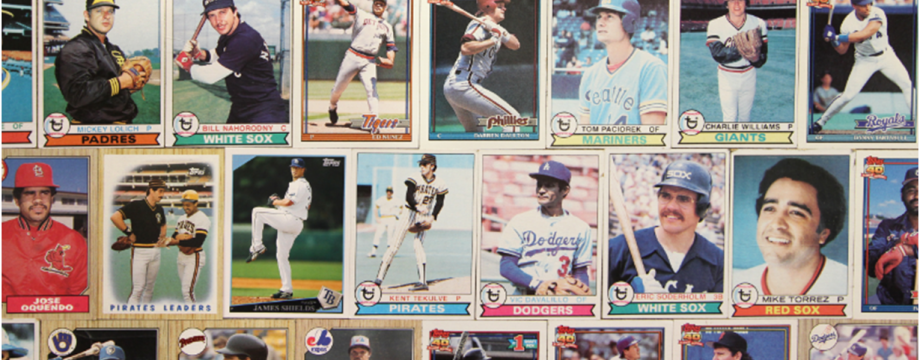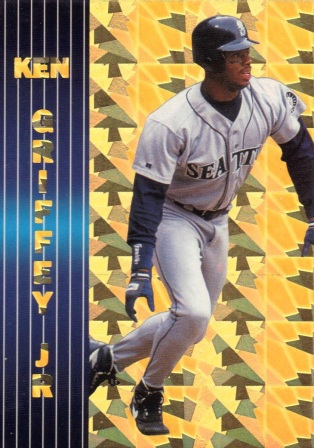” The greatest trick the devil ever pulled was convincing the world he did not exist. And like that… he is gone.”
There’s not much public information about Rob Broder, even now in 2015, when pretty much everything is public knowledge thanks to the Internet. What little is known about this notorious card counterfeiter is that he is the son of Ed Broder, who made some cards in the 60s and 70s, and that he worked as a photographer for Major League Baseball at one point or another. While his photography skills didn’t impress all that much, his ability to impact an industry in a short amount of time is nothing short of amazing.
These unlicensed cards, which littered shops and trade shows in the late-80s and early-90s, had little value to many collectors then and to this day. Back during their hey day, I didn’t even know they existed. Back in 1990, all I cared about was Upper Deck, Topps, Donruss, Fleer, and the rest of the “real” card manufacturers. I despised unlicensed, “oddball” cards that were being put out from companies like Pepsi, 7/11, and other retailers who had no business in our hobby.
Then again, Broder cards were most definitely not unlicensed. Logos were always in plain view, as were full team names. It is believed that Rob Broder was an up and coming photographer who wanted to get his name out to the public and producing huge quantities of cards was his way of doing it. It’s then somewhat ironic that what destroys most Broder cards is the one thing that was there to promote it, photography. Most, if not all these photos could have been taken by just about anyone who could hold a camera.
Here’s an example of a Broder Jose Canseco set, which I once paid $5 dollars for at a card show in 2008. Two cards of Jose in almost identical poses but different uniforms, most likely taken during a Spring Training game. Three cards of Jose posing but never looking into the camera. One card of Jose leading off a base. Three photos of Jose hitting batting practice with cage in plain view. There you have it. Not one single iconic shot in any set, ever. Just point and shoot, print and move on.
Despite their short-comings, Broder cards exploded into the market and that’s definitely something you can’t take away. I myself began receiving them during the early days of eBay in huge card lots and kept picking them up over the years due to curiosity and because my player, Jose Canseco, was one of the main Broder card stars featured year after year. Does that make me a fan? Well, obviously, YES. Rob Broder and whoever was helping him create these cards made a dent in our hobby and as complete underdogs. You gotta love that!
Broder cards continued leaking into card shows and shops into the early-90s but it’s believed that by that point Rob Broder had ceased all operations due to what one collector who claims he was in the know referred to as a “really angry letter from MLB”. The cards kept coming, though and even evolved from the full-bleed photography they were known for into flashy cards featuring foil and insert-like designs. Unfortunately, by the mid-90s, MLB cracked down hard and put an end to Broder cards for good.
Now it’s time to ask the important questions. WHO IS ROB BRODER? WHERE IS HE TODAY? If ANYONE has any information, please contact me ASAP. Let’s get the word out and track down a hobby hero and/or villain depending on what side you stand on. Rob deserves to have a chance to explain to us what his intentions were and exactly what caused him to walk away from it all (besides the impending lawsuits). The card collecting world, well, a good portion of it, wants to know how it all went down and only one man can fill in the pieces.
Rob Broder, come on down ….






3rd paragraph you refer to Rob as Ed.
Thanks!
Hello I know rob broder very well back in late 80’s used help him pack up all his orders and we bring to ups and mail them here in hawaii ok thanks jim
I sure hope someone leaves a comment with the 411. I’d love to see what Mr. Broder is up to. Whenever I see his cards in dime boxes, I’ll usually grab them. They might not be worth much (hence the dime boxes), but they’re cards with players I collect… so I’ll pick them up.
I think you’re being a bit unfair on the quality of the photography. Yes, some sets were pretty weak and grainy, but others had much better photography than anything that was being produced by the big four from 1987-1988. Until Upper Deck came along, baseball card photography was overwhelmingly grainy, blurry, and dark. I never understood why so many photos that were clearly taken during spring training, in the sunny Florida, were all taken on overcast days near dusk. Good, sharp, bright photos on baseball cards were the rare exception on anything being put out by Topps and Fleer.
These “unlicensed collector issues”, as Bob Lemke always referred to them, offered a lot more cards of players many collectors were looking for, especially the rookies. Now I never understood why anyone thought these cards would appreciate in value, but I did see the appeal. Back when they were being issued, I’d grab all the cards of Dave Winfield I could find because they were something different. And thanks to these sets, I’ve got 5-6 more cards of Hensley Meulens and Roberto Kelly that would have otherwise been available. They may not be the best looking cards in the world, but when one gets into the >95% range of completion in a player collection, these offer something else to chase.
In addition to Rob Broder (who was using a Killeen, TX address on the back of his early sets, implying that Ed Broder might have retired from the Army at Fort Hood), there was also a similar set attributed to Scott Cunningham, and then there were a ton of sets with a “Pacific Cards & Comics” indicia on the back. Allegedly, Rob Broder ultimately did pursue a license, which resulted in those 1989-1990 Playball sets that featured MLB and MLBPA logos. Somewhere I saw an article in an old issue of Baseball Cards Magazine about a settlement being reached with MLB, but I don’t think Broder was mentioned by name. The editors of Baseball Cards were always very negative in the letters pages about unlicensed card sets, even though their pages were full of dealers selling them.
Be sure to check out http://www.supercollectorcatalog.com where Tim Peichel has assembled a great database of many of these sets.
This was great article by Mario and a good comment by you. Thanks for leaving it! I have the same feelings towards Broder, but my focus is Will Clark. You brought up “Scott Cunningham” and “Pacific Cards and Comics”. I will add that other card backs featured markings, such as “Blue Sox Sports Promotions, Phoenix, AZ”, “Big Apple Card Co.”, “The Press Box”, “Grand Slam Baseball”, “Indiana Blue Sox, Inc.”, “The Shanks Collection”, and of course, “Play Ball”. It’s not clear to me if all of these were Broder, but I suspect some/most.
Hey you should give me a call I have some questions about broder cards! I have over 250,000 of them
Jason, thank you so much for that comment and information.
Pingback: Random Awesomeness (part 182) | The Writer's Journey
I loved the Broder cards. If you wanted a Chris Sabo card in early 1988, his “Rookie” sets were the only place to find them. I didn’t mind that several of the photos were only seconds apart from each other.
i just came across this web page and i was a fan of Rob Broder cards. I collect Don Mattingly and i have numerous Broder cards in my collection. There is a card shop i go to in Ohio that has been there for a very long time. The owner and i was talking about Rob Broder a few years ago and he told me that Broder had married a girl from Hawaii and that all the money he made from the sports cards he sold, they bought a lot of property in Hawaii. He also told me that Rob Broder spent time in prison for his bootlegging of cards but im not sure how true that is. He said he had been to a warehouse to retrieve a emergency shipment of cards and he said you wouldnt believe the sports cards of different sports and players that was there. He said they were all broken off and organized by sport and player. Millions upon millions of cards. I wish ESPN would do a 30 for 30 or Behind the Lines or some kind of segment,documentary or something about Rob Broder. I think it would be fascinating especially to the generation of card collectors who didnt even know who he was or the impact he made on our generation. He sure had an impact on the hobbie for quite a while.
Mario, did you mean to post a picture(s) of Canseco per paragraph 4 of your article?
I think I probably have about 250,000 of his cards that he made. Check them out on my eBay pages dwanew63 and betmil7025